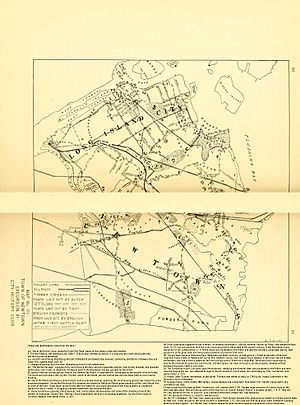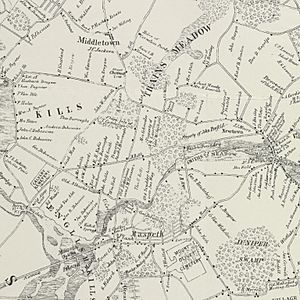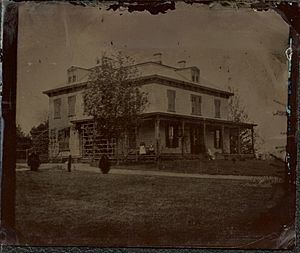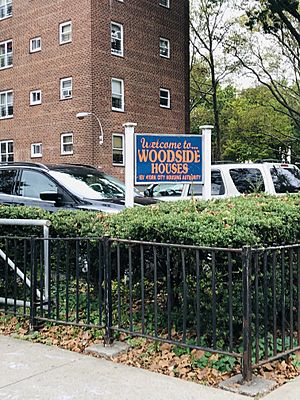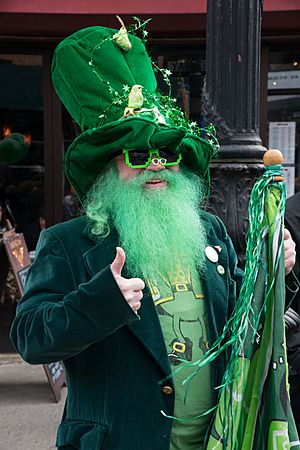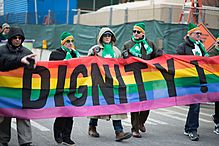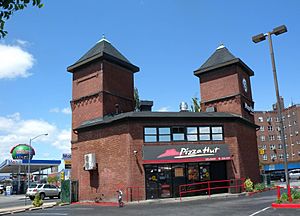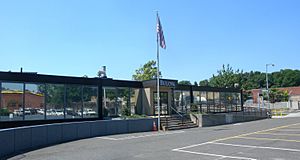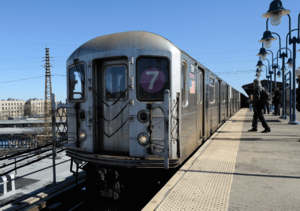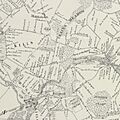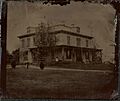Woodside, Queens facts for kids
Quick facts for kids
Woodside
|
|
|---|---|
|
Neighborhood of Queens
|
|

Former Childs Restaurant branch at 60th Street and Queens Boulevard in Woodside
|
|
| Country | |
| State | |
| City | |
| County/Borough | |
| Community District | Queens 2 |
| Population | |
| • Total | 45,099 |
| Ethnicity | |
| • Asian | 39.9% |
| • Hispanic | 33.5% |
| • White | 22.5% |
| • Black | 1.3% |
| • Other/Multiracial | 2.8% |
| Economics | |
| • Median income | ,415 |
| Time zone | UTC−5 (EST) |
| • Summer (DST) | UTC−4 (EDT) |
| ZIP Code |
11377
|
| Area codes | 718, 347, 929, and 917 |
Woodside is a busy neighborhood in the western part of Queens, a borough of New York City. It's a place where people live and work. Woodside is surrounded by other neighborhoods like Maspeth to the south and Astoria to the north.
In the 1800s, Woodside became a big home for Irish American families. By the 1930s, about 80% of the people here were Irish. Today, Woodside still has a strong Irish culture. In the early 1990s, many Asian American families, especially from the Philippines, moved to the area. Now, about 30% of the people are Asian American. People from South Asia and Latin America have also moved to Woodside recently.
Because of all these different cultures, Woodside has many kinds of restaurants and pubs. You can find some of the city's best Thai, Filipino, and South American places to eat here.
Woodside is part of Queens Community District 2. Its ZIP Code is 11377. The New York City Police Department's 108th Precinct keeps the area safe.
Contents
Woodside's History
How Woodside Began
For about 200 years after settlers arrived from England and the Netherlands, the Woodside area was mostly empty. The land was good for farming but also very wet. Native Americans called it a place of "bad waters." Early European settlers described it as "marshes, muddy flats and bogs." There were also "wooded swamps" and "flaggy pools."
Farmers began settling in Woodside in the early 1700s. They learned how to farm the land well. The marsh grasses were good for grazing animals. Grains, fruits, and vegetables grew on the drier land. By the mid-1700s, farmers had drained some marshes and cut down some woods. This helped them expand their farms and get rid of wild animals.
By the early 1800s, the area was known for its wealthy farmers and beautiful homes. One historian from the late 1800s said a farm here was a lovely mix of woods, fields, and gardens. He thought it was one of the most beautiful places near New York.
In the 1800s, Woodside was part of the Town of Newtown, which is now Elmhurst. A nearby area called Winfield became part of Woodside's post office. Because of this, Winfield lost some of its own identity.
An old landmark in Woodside was a huge chestnut tree. It was hundreds of years old and stood on high ground where three dirt roads met. The tree was very wide, about 8 to 10 feet across. Its size made it a natural meeting place. People would tack public notices on it. It was also important during the Revolutionary War.
Woodside started to grow a lot in 1867. Builders like Benjamin W. Hitchcock and John Andrew Kelly began creating new homes. Woodside was a great spot for a new suburban town. It was only about three miles from Hunter's Point on the Long Island Rail Road line.
Farming and Transportation
By the mid-1800s, about two-thirds of Woodside's land was good for farming. Farmers grew flowers, fruits, and vegetables. They also produced dairy products to sell in New York City. Transportation improved, making it easier for farmers to get their goods to market.
Roads were built from Newtown to Williamsburg and Hunters Point. This made it quicker to reach ferries on the East River. In 1860, a toll road was built between Flushing and Hunters Point. This road is now similar to Northern Boulevard.
Large Country Estates
Better transportation eventually led to less farming. As it became easier to travel to other parts of Queens, Brooklyn, and Manhattan, Woodside became a desirable place to live. Land values went up, and farm owners started selling their land for housing.
Wealthy merchants bought farm properties to use as country estates. They would live there during the warmer months. John A. Kelly and William Schroeder, both from German families, bought land for this purpose. Later, Gustav Sussdorf and Louis Windmuller also created country retreats in Woodside. These estates were beautiful, with gardens and open spaces.
Building New Homes
Over time, these large country estates were divided into smaller lots for homes. This happened in the decades after 1850. Again, better transportation was the main reason for this change.
In 1854, the first steam-powered passenger train service came to the area. A train station opened near Woodside's southern border. This line connected to New York City by ferry. In 1861, another train line, the Long Island Rail Road, opened directly through Woodside. More train lines followed, making it very easy to travel.
These new train services led to land being divided into small lots. Houses were built for working-class families. Woodside's developers were among the first to sell these small homes using new sales methods. They also gave the area the name "Woodside," which means "next to the woods."
Benjamin W. Hitchcock was a key developer. He was known for his creative sales ideas. In 1869, he organized trips from the city to Woodside. He hired bands and offered free lunch to potential buyers. He sold empty lots for $300 on an installment plan. Buyers paid a down payment and then $10 a month. He even used lotteries, offering the best lots or even houses as prizes.
Other developers followed Hitchcock's lead. They bought land and divided it into building lots. Some areas were given new names, like Charlotteville and Woodside Heights.
Even with all this building, Woodside was not completely full of homes by 1909. The small single-family houses were still too expensive for many workers. These workers lived in crowded apartments in Manhattan and Brooklyn. After 1907, many of these workers wanted better housing that they could still afford. Developers realized they could build apartment buildings in Woodside to meet this need.
Why Woodside Grew
One big reason Woodside grew was the improved public transportation. The Long Island Rail Road became electric in 1908. The subway opened in 1917. Electric trolleys also ran through the area.
When Queens became part of New York City in 1898, a five-cent transit fare was set in 1904. This made travel very cheap. The Queensboro Bridge (1909) and the Steinway Tunnel (1915) connected Woodside to Manhattan. A five-cent subway trip could take as little as eight minutes to Times Square. Woodside was special because it had both railroad and subway stations, plus trolley lines.
Another reason for growth was more job opportunities nearby. Industries and businesses grew in western Queens. Places like Hunters Point and Sunnyside had factories, rail yards, and chemical works. The famous Steinway Piano factory was also nearby. By the early 1900s, Long Island City (which included these areas) had a huge amount of industry.
Woodside itself also had jobs. The large Calvary Cemetery brought business. There was also a brewery, a florist, and many local shops. In 1875, the Bulova Watch Company set up its headquarters here.
Woodside also had many nice things to offer. It was a pretty place with open spaces, trees, and fresh air. People called it "sylvan beauty" in 1926. When Queens became a borough in 1898, local government improved. More money was spent on police, roads, schools, and parks. Woodside already had fire protection, sewers, and street lights. Its transit lines also led to many shops. P.S. 11 was even called "one of the leading public schools in Queens."
Churches were important to Woodside residents. In 1854, St. Mary's Winfield became the first Catholic church. St. Paul's Protestant Episcopal Church was built in 1874 by the older, wealthy families. A Baptist church was set up two years later. St. Sebastian, the first Roman Catholic church in Woodside proper, opened in 1896 and quickly grew to 1,000 members.
Woodside also had fun places to go. One of its first businesses was a brewery with rooms for people to gather. In the late 1800s, it became famous for its beer gardens and dance halls. Julius Adams, an early resident, built Sanger Hall in 1881. It was a German-style beer hall, dance hall, and performance space. He later added dining rooms and a bowling alley. Heimann's Hall, another beer garden and dance hall, opened in 1889. Early in the 1900s, a movie theater also opened.
Woodside in the 1900s
As the 1900s began, developers built more apartment buildings and duplex homes. These joined the single-family houses already there. The Woodside Apartments were built in 1913 near the train stations. They had four-story buildings with four-room apartments. Rents were about $18 to $20 a month.
The Metropolitan Life Insurance Company built an even bigger apartment project in 1922. It had ten five-story buildings with space for 400 families. The Woodside Development Corporation built four-story apartments with stores on the ground floor. They also built two- and one-family houses. By 1924, Woodside had many apartment buildings and duplexes, along with its single-family homes.
Building continued in Woodside during the 1930s and after World War II. Empty lots were filled with houses and apartment buildings. Larger, taller apartment buildings were also constructed. In 1936, a large piece of undeveloped land from the Windmuller Estate was sold for new garden apartments.
A report in 1943 described Woodside as a "district of small homes and middle incomes." It still had few apartment buildings and little industry. Even though population growth slowed in the 1930s, new subway lines (like the IND Queens Boulevard Line in 1933) and a new shopping center were expected to bring more people. At that time, Woodside had 2,159 single-family houses, 1,711 double-family houses, and 868 larger residential buildings.
In 1949, the Woodside Houses were finished. This is a public housing complex built by the New York City Housing Authority. It has 20 six-story buildings with 1,358 apartments. It is located in western Woodside, near Astoria.
Woodside Today
By the early 2000s, Woodside was mostly built up. It was still seen as a nice place to live. It has "wide avenues, leafy streets and a mix of private homes, small apartment buildings and the occasional towering co-op."
The population grew a lot over the years:
- 1880: about 1,800 people
- 1900: 3,900 people
- 1920: 15,000 people
- 1930: 41,000 people
- 1963: about 55,600 people
- 2000: 90,000 people
In 2008, a local leader said that larger apartment buildings were replacing smaller ones. Single-family homes were also being changed into multi-family rentals. Real estate agents said that families still wanted to find affordable homes close to Manhattan.
Woodside's Population
In 2010, Woodside had 45,099 people. This was a small increase from 43,846 people in 2000. The neighborhood covers about 649 acres.
The people living in Woodside come from many different backgrounds:
- 22.5% White
- 1.3% African American
- 0.2% Native American
- 39.9% Asian
- 0.0% Pacific Islander
- 0.5% from other races
- 2.2% from two or more races
- 33.5% are Hispanic or Latino
In 2018, the average life expectancy in Woodside and Sunnyside was 85.4 years. This is higher than the average for New York City. Most people living here are middle-aged adults and young people. About 17% are under 18, 39% are between 25 and 44, and 24% are between 45 and 64.
In 2017, the average household income in Woodside and Sunnyside was $67,359. About 20% of residents lived in poverty in 2018. This is similar to the rest of Queens and New York City. About 5% of residents were unemployed.
Woodside's Culture
A Mix of Cultures
Woodside's population has changed a lot over time. The first people here were Native Americans. Then came European landowners, mostly Dutch and English. Later, Germans became a big part of the community. Many of the first people to buy homes from Benjamin Hitchcock were German.
At the end of the 1800s and through most of the 1900s, many Irish people moved to Woodside. It became so Irish that it was nicknamed "Irishtown." A big moment for the Irish community was in 1901. The Greater New York Irish Athletic Association opened Celtic Park, a large sports complex. More Irish people moved to Woodside in the 1980s and early 1990s. They came because of tough economic times in Ireland. Many found jobs in construction or as waitresses and nannies.
Today, Woodside is home to many different nationalities. But it still has a strong Irish American presence. You can find many Irish pubs and restaurants here. After World War II, families were mostly Irish, Italian, and Jewish. Later, people from the Dominican Republic and other countries began to move in.
This mix of cultures is seen in Woodside's places of worship. For example, the Winfield Reformed Church started as a Dutch church in 1880. In 1969, it became the first Taiwanese church in America. Woodside also has Hindu temples, Thai Buddhist temples, Romanian Orthodox churches, and Filipino, Korean, and Chinese places of worship. There is also a strong Muslim community and the Islamic Institute of New York.
A priest at St. Sebastian church said that about 45% of its members are Hispanic (especially from Colombia and Mexico). About 25% are Irish, 25% Filipino, and 5% Korean. In 1999, people in Woodside came from 49 countries and spoke 34 different languages!
In the early 1990s, many Asian American families moved to Woodside. This was especially true near the 61st Street – Woodside subway station. In 2000, 30% of Woodside's population was Asian American. Woodside has many Thai Americans, Korean Americans, Chinese Americans, and Filipino Americans. Each group has its own special area with businesses. There are also many South Asian Americans, like people from India, Bangladesh, Nepal, and Pakistan. A large Dominican and Latino population also lives here.
Because of its diverse cultures, Woodside has many different restaurants and pubs. It's known for its Thai, Filipino, Colombian, and Ecuadorian food. Woodside also hosts many festivals and street fairs. It has its own Saint Patrick's Day parade before the big one in Manhattan. Woodside also has summer events, including an Independence Day street fair.
Little Manila
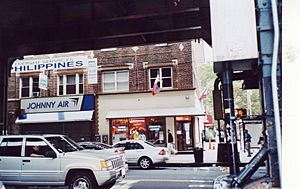
"Little Manila" is an area from 63rd to 71st Streets on Roosevelt Avenue. Many Filipino-owned businesses are here, serving Woodside's large Filipino American community. The neighborhood is famous for having so many Filipinos.
Filipino cafes and restaurants are common in this area. There are also freight and money transfer centers. Other Filipino businesses include medical and dental offices, driving schools, beauty salons, and immigration services. This area attracts Filipinos and non-Filipinos from nearby places like Long Island, Connecticut, Pennsylvania, and New Jersey.
In February 2008, the Bayanihan Filipino Community Center opened in Woodside. The Philippine Forum helped start this project. The Philippine Forum also holds the annual Bayanihan Cultural Festival in September. This festival celebrates Filipino American History Month.
On June 12, 2022, the intersection of 70th Street and Roosevelt Avenue was renamed "Little Manila Avenue." This celebrated the Filipino community's growing presence and contributions in Queens.
St. Patrick's Day Parade
Woodside hosts New York City's only Saint Patrick's Day parade that welcomes members of the LGBTQ+ Irish community. It is called the St. Pat's for All Parade.
History of St. Pat's for All
In 1991, an Irish LGBTQ+ group was not allowed to march in the main St. Patrick's Day Parade in Manhattan. After some legal decisions, it was ruled that private groups could choose who marched in their parades.
Because of this, Brendan Fay started the Lavender and Green Alliance (LAG). This group organized an inclusive event called "St. Pat's for All." It was open to anyone who wanted to celebrate Irish culture. The parade's slogan is "Cherishing All the Children of the Nation Equally." This comes from the 1916 Easter Proclamation of the Irish Republic. The first parade was held on March 5, 2000.
The St. Pat's for All parade created a welcoming community for Irish people who are also LGBTQ+. People from many different cultures and backgrounds attend this parade. In its first year (2000), over 70 groups participated. These included the Korean community, Chilean musicians, and various LGBTQ+ organizations.
This parade is special because it welcomes everyone who wears green, no matter their background or identity. It is seen as a truly open and welcoming celebration of Irish culture.
Many important politicians have attended the parade. These include former New York City mayors Rudy Giuliani and Michael Bloomberg, and former U.S. Senator Hillary Clinton.
The St. Pat's for All Parade celebrated its 20th anniversary on March 3, 2019.
Fire Safety
Woodside is protected by two New York City Fire Department (FDNY) fire stations:
- Engine Company 325/Ladder Company 163 at 41-24 51st Street
- Engine Company 292/Rescue 4 at 64-18 Queens Boulevard
FDNY EMS Station 45 is also located at 58-65 52nd Road.
Post Office and ZIP Code
Woodside uses the ZIP Code 11377. The United States Post Office has its Woodside Station at 39-25 61st Street.
Education
Woodside and Sunnyside generally have more college-educated residents than the rest of New York City. In 2018, about 45% of adults aged 25 and older had a college degree or higher. About 19% had less than a high school education, and 35% were high school graduates or had some college.
Students in Woodside and Sunnyside are doing well in school. The percentage of elementary school students doing well in math went from 40% in 2000 to 65% in 2011. Reading achievement also improved from 45% to 49% in the same time.
Fewer elementary school students miss many days of school in Woodside and Sunnyside. Only 11% missed 20 or more days in a school year. This is lower than the city average of 20%. Also, 86% of high school students here graduate on time, which is higher than the city average of 75%.
Schools in Woodside
Woodside has several public schools:
- PS 11 Kathryn Phelan (grades K-6)
- PS 12 James B Colgate (grades K-5)
- PS 151 Mary D Carter (grades PK-5)
- PS 152 Gwendolyn N Alleyne School (grades PK-5)
- PS 229 Emanuel Kaplan (grades PK-5)
- IS 125 Thomas J McCann Woodside Intermediate School (grades 6–8)
- William Cullen Bryant High School (grades 9–12)
There are also private schools:
- Corpus Christi Elementary School
- Greater New York Academy
- Razi School
- Saint Sebastian's Elementary School
Woodside Library
The Queens Public Library has a branch in Woodside. It is located at 54-22 Skillman Avenue.
Green Spaces and Parks
Woodside has several parks for recreation:
- Doughboy Plaza: This park is at Woodside Avenue, 52nd Street, and 39th Road. It used to be a playground but is now a landscaped area.
- Windmuller Park (now Lawrence Virgilio Playground): Located between 39th Road and 39th Drive, from 52nd to 54th Streets. It was named after Louis Windmuller, a local businessman. In 2002, it was renamed after Lawrence Virgilio, a firefighter who died on September 11, 2001. The park has fields and courts for baseball and handball. It also has a playground, a spray shower, a running track, a swimming pool, and fitness equipment.
- Big Bush Park: On the north side of Laurel Hill Boulevard, between 61st and 64th Streets. It was built on land created during the construction of the Brooklyn-Queens Expressway in the 1950s. It opened in 1987. The park has fields and courts for baseball, basketball, handball, and soccer. It also has a playground, a spray shower, and fitness equipment.
- Nathan Weidenbaum Playground: On the south side of Laurel Hill Boulevard at 61st Street. It was named after a local resident who helped improve the area.
- John Vincent Daniels Jr. Square: Located at 43rd and Roosevelt Avenues, between 50th, 51st, and 52nd Streets. This square honors Vincent Daniels Jr., a Woodside resident who died in World War I in 1918.
The Moore-Jackson Cemetery on 51st and 54th Streets also has a community garden. This cemetery is a New York City designated landmark. It is one of the oldest cemeteries in New York, started in 1733.
Important Structures
Even with many changes over the years, some old landmarks remain in Woodside. The double-decker station for the Long Island Rail Road (built in 1869) and the IRT Flushing Line (built in 1917) are still there. They were updated in 1999.
A former trolley car barn at Northern Boulevard and 51st Street has been saved. It is now the Tower Square Shopping Center. The New York and Queens Railroad Company built this barn in 1896. It was the largest car barn in Queens.
Woodside also has a very old copper beech tree. It is between 150 and 300 years old. Some records suggest it might have been planted during the Revolutionary War.
Some of Woodside's oldest landmarks are its cemeteries. Calvary Cemetery was started in 1845 for Roman Catholic burials. It is very large, with over three million burials. The Moore-Jackson Cemetery is much older and smaller. It was established in 1733.
The Bulova Corporation has its main office in northern Woodside, near Interstate 278. Their headquarters opened there in 1875.
Some of Woodside's old buildings are still standing. St. Paul's Protestant Episcopal Church, Woodside's first church, was damaged by fire in 2007 but is still in its original spot. Other old buildings from the 1800s include the Hook and Ladder Company (1884), the home of Otto Groeber (1870), the Woodside Pavilion (1877), and Meyer's Hotel (1882). The Winfield Reformed Church is also in Woodside.
Transportation
The New York City Subway's IRT Flushing Line (7 <7> trains) has stations in Woodside. These are at 52nd (local), 61st (express), and 69th Streets (local) on Roosevelt Avenue. The IND Queens Boulevard Line local trains (E M R trains) stop at Northern Boulevard and 65th Street along Broadway.
The Woodside station of the LIRR is connected to the 61st Street subway station. Several Q18, Q32, Q39, Q47, Q53 SBS, Q60, Q70 SBS buses connect Woodside to other parts of Queens. The Q32 and Q60 buses go to Manhattan. The Q70 SBS and Q47 buses go to LaGuardia Airport.
Major highways pass through Woodside. These include the Brooklyn-Queens Expressway (I-278) and the Long Island Expressway (I-495). Northern Boulevard (NY 25A) and Queens Boulevard (NY 25) also run through Woodside.
Notable Residents
Many interesting people have lived in Woodside:
- Edward Burns (born 1968), actor
- James Caan (1940–2022), actor
- Francis Ford Coppola (born 1939), movie director
- Morton Feldman (1926–1987), composer
- Joel Klein (born 1946), former New York City Schools Chancellor
- Chris Gethard (born 1980), comedian and author
- Evelyn Fox Keller (born 1936), physicist and author
- Harry Marmion (1931–2008), former president of the United States Tennis Association (USTA)
- Frank McCourt (1930–2009), Pulitzer Prize-winning author
- Edmar Mednis (1937–2002), chess grandmaster
- Jack Mercer (1910–1984), voice actor (voice of Popeye the Sailor)
- Robert Emmett O'Malley (born 1943), U.S. Marine and Medal of Honor recipient
- Thomas J. Pickard (born 1950), former acting Director of the Federal Bureau of Investigation
- Charlotte E. Ray, (1850–1911), the first Black American female lawyer
- Lynn Samuels (1942–2011), radio host
- Joe Spinell (1936–1989), actor
Images for kids


